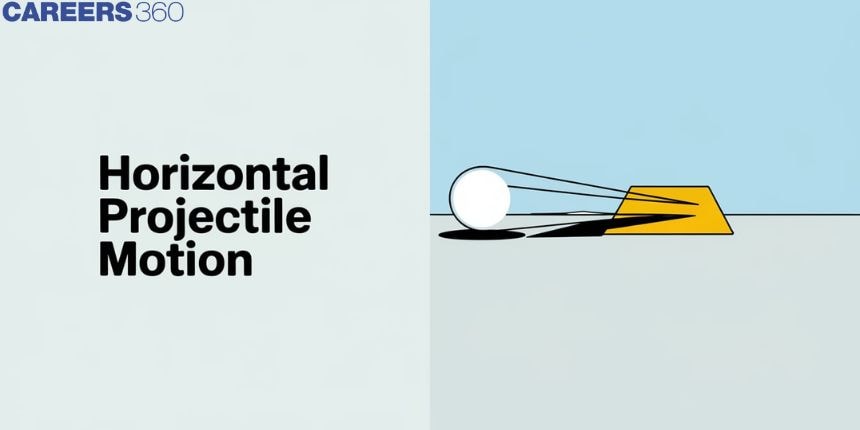Horizontal Projectile Motion
Horizontal projectile motion is a special type of projectile motion when a body is thrown or launched by means of an initial velocity that has absolutely no vertical component at the time of take-off. This type is analogous to many real-life observations, and its applications cut across disciplines and professional areas.
In horizontal projectile motion, the object moves forward with a constant horizontal velocity while simultaneously accelerating downward due to gravity. It implies a parabolic trajectory, where the object's path curves downward while travelling horizontally. In aviation, understanding the principle of horizontal projectile motion is required to drop supplies or equipment from an aircraft so that they land accurately at the target location. The same concept aids spacecraft engineers in working out a spacecraft landing trajectory to land on other planets or moons.

In this article, we will cover the concept of projectile motion. This concept we study in chapter kinematics which is a crucial chapter in Class 11 physics. It is not only essential for board exams but also for competitive exams like the Joint Entrance Examination (JEE Main), National Eligibility Entrance Test (NEET), and other entrance exams such as SRMJEE, BITSAT, WBJEE, BCECE and more. Over the last ten years of the JEE Main and NEET exams (from 2013 to 2023), two questions from each have been asked on this concept.
Horizontal Projectile Motion
Let's start with some important equations, which are initial velocity after t sec, displacement acceleration and path of projectile and more.
Important Equations
- Initial Velocity (u):
Horizontal component =ux=u
Vertical component =uy=0
Velocity 'v' after time 't' sec-

Horizontal component =vx=u
Vertical component =vy=g.t
and,
v=vx2+vy2 i.e; v=u2+(gt)2tanβ=gtu
Where, β= angle that velocity makes with horizontal
- Displacement (S):
Horizontal component =Sx=u.t
Vertical component =Sy=12g⋅t2
and, S=Sx2+Sy2
Acceleration =a
Horizontal component =0
Vertical component =g
So, a=g
So, a = g
- Equation of path of a projectile

y=g2u2⋅x2
g→ Acceleration due to gravity
u→ initial velocity
Till now we have studied the important equation now coming to the important terms.
Important Terms

- Time of flight
t=2hg
where t is the time of flight and h= Height from which the projectile is projected.
- Range of Projectile
R=u⋅2hg
Where R is the Range of projectile and u is the horizontal velocity of projection from height h
- Velocity at which projectile hit the ground
v=u2+2gh
Where v is the velocity at which the projectile hit the ground.
Recommended Topic Video
Solved Example Based on Horizontal Projectile Motion
Example 1: A particle is projected with a speed of 4m/s along a horizontal direction from a height. The equation of its path is:
1) y=513x2
2) y=1316x2
3) y=516x2
4) y=3x2
Solution:
Given:
x=4t−(1)y=12gt2=5t2−(2)
From 1 and 2:
y=516x2
Hence, the answer is option (3).
Example 2: A particle is projected in the horizontal direction from a height. The initial speed is 4m/s. Then the angle made by its velocity with horizontal direction after 1 second is :
1) tan−1(25)
2) tan−1(52)
3) tan−1(12)
4) tan−1(13)
Solution:
For Projectile Projected Horizontally -

tanβ=gtu
where
β= the angle that velocity makes with horizontal
So Angle with horizontal is
θ=tan−1(gtu)⇒θ=tan−1(104)=tan−1(52)
Hence, the answer is option (2).
Example 3: A helicopter flying horizontally with a speed v at an altitude h has to drop a food packet for a man on the ground. What is the distance of the helicopter from the man when the food packet is dropped?
1) 2v2hg+h2
2) 2ghv2+h2
3) 2ghv2+h2
4) 2ghv2+1h2
Solution:

x=vt=v×2hg
r→ distance of man and helicopter
r=x2+h2r=v2×2hg+h2
Hence, the answer is option (1).
Example 4: A stone is thrown horizontally with a velocity of 10 m/s. Find the radius of curvature of its trajectory at the end of 2 seconds after motion began (g=10 m/s2)
1) 10010 m
2) 505 m
3) 5 m
4) 235m
Solution:
y=−gx22u2dydx=−gx2u2=d2ydx2=−gu2 After t=2secx=uxt=20 mdydx=−20g(200)2=−2d2ydx2=−10100=−110R=[[1+(dydx)2]3/2]d2ydx2]=[(1+(−2)2)3/2−110]=53/2110=505
Hence, the answer is the option (2).
Example 5: A child stands on the edge of the cliff 10 m above the ground and throws a stone horizontally with an initial speed of 5 ms−1. Neglecting the air resistance, the speed with which the stone hits the ground will be ms−1 (given, g=10 ms−2 ).
1)15
2)20
3)30
4)25
Solution:

Along vertical direction
vy2=uy2+2aygy=(0)2+2×10×10vy2=200
sy=10 mvy2=200∴v=vx2+vy2=25+200=225=15 m/s
Hence, the answer is option (1).
Summary
In conclusion, the basic underlying idea that covers the core of this concept is that of the horizontal projectile motion in physics. Utilizing initial horizontal velocity, this particular type of motion includes the constant horizontal speed of the object and the vertical acceleration known to change the speed, resulting in a parabolic trajectory. Understanding the principles of horizontal projectile motion, one will realize that there are different ways to use the concept in real life to achieve precision and safety in certain activities, for example, in designing rides in amusement parks or in ensuring that projectiles hit their targets with precision. It gives knowledge that will come in handy in various life situations to solve practical problems and create innovations.